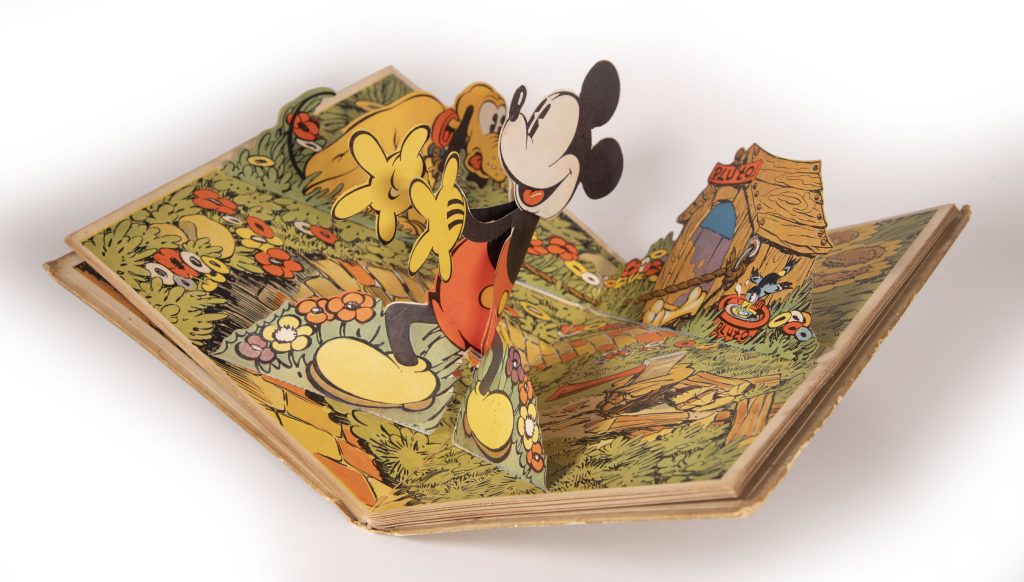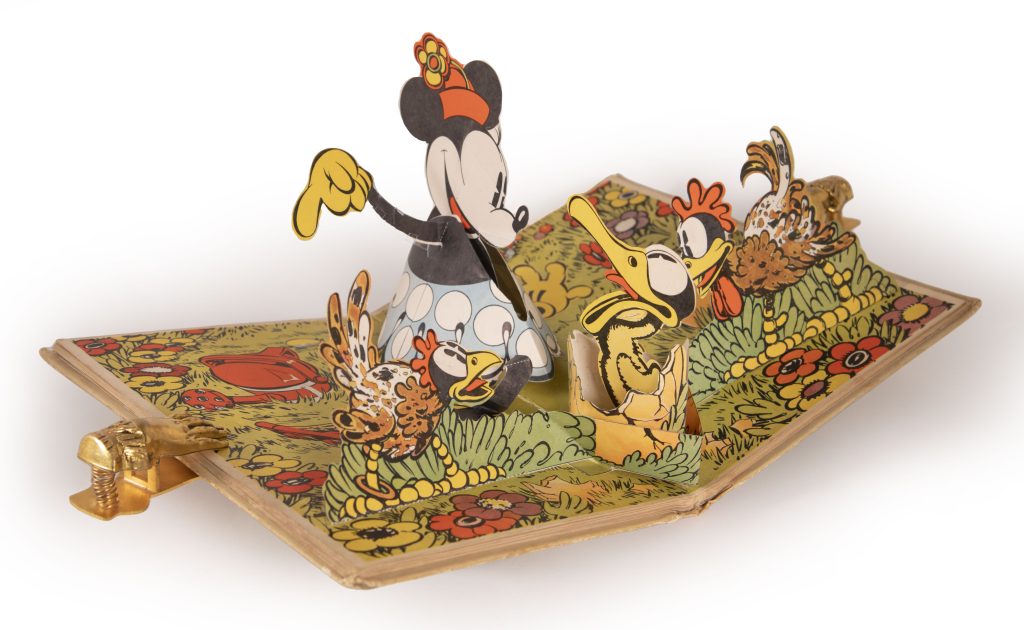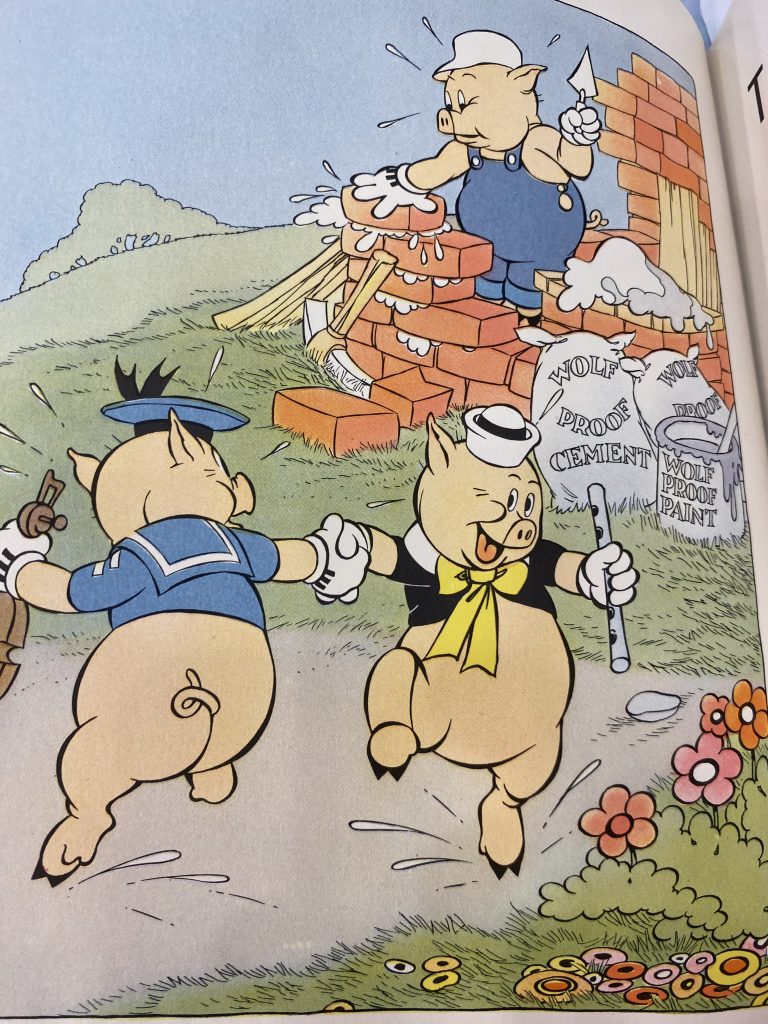By Kamden Spies, Lilly Library desk attendant and graduate student in the Department of Information & Library Science
By 1932, Mickey Mouse was arguably the most beloved figure in American cinema. His cheerful outlook had brought America a smile during the Great Depression. As Walt Disney was looking for new ways to help his studio grow, he wanted to find new ways to earn profits to help further fund Mickey Mouse shorts and the experimental Silly Symphonies cartoon series. 1932 was a big year for the Silly Symphonies, as this was the year that Flowers and Trees, the first three-strip technicolor cartoon, would premiere.
Movable books date back as early as the 11th century. However, pop-up books didn’t begin marketing in the United States until the early 1930s. Blue Ribbon in New York City began producing imaginative pop-up books. It was Blue Ribbon that coined the term “pop-up.” Mickey Mouse was a popular figure to children and adults around the world. His animated cartoons sparked an international “Mickey Mouse Club” held at local theaters, which, by 1932, boasted over one million members all over the world. 1932 was also the introduction of the novelty song “What No Mickey Mouse?” symbolizing the expectation to see a cartoon before any theatrical feature in theatres.
In 1933, the Disney comic strip department was going incredibly strong. The Mickey Mouse comic strip and its Silly Symphonies topper were very successful. When Mickey Mouse comic strip artist Floyd Gottfredson wasn’t busy with his strip, he supervised Tom Wood in Disney’s publicity department. Before the studio publicity department branched into its own section at the Disney studio, one of the last collaborations between artists Tom Wood, Floyd Gottfredson, Al Taliaferro, and inker Ted Thwaites was the Mickey and Minnie pop-up books published by Blue Ribbon. Very little of the Mickey or Minnie pop-up books actually popped up. Instead, most of the art was either taken directly from the Mickey Mouse comic strip or were new illustrations by Tom Wood. Wood drew much of the pop-up books, including the covers. In all, there were five Disney pop-up books: The Pop-Up Mickey Mouse, The Pop-Up Minnie Mouse, The Pop-Up Mickey Mouse in Ye Olden Days, Mickey Mouse in King Arthur’s Court, and Silly Symphonies. The Lilly Library has three of these pop-up books in the collection.
In The Pop-Up Mickey Mouse, three illustrations feature Mickey, Minnie, and their animal friends pop up. Each pop-up is wonderfully designed and beautifully produced. The first and third pop-ups are simple illustrations that help liven the book. However, the second pop-up is what stands out as spectacular. The pop-up features Mickey Mouse popping directly off the page, hands sticking out, with Pluto behind him tied to his doghouse. This would’ve been exciting for any American due to the relatively new concept that pop-up books were in the United States at the time.

The Pop-Up Minnie Mouse is actually more complex and well-produced than Mickey’s book. However, its individual pop-ups doesn’t stand out as strongly as Mickey’s major pop-up page. Minnie’s features Mickey, Clara Cluck, and The Ugly Duckling reappearing from his 1931 Silly Symphony. Tom Wood designed the cover and illustrated all of the pop-ups with brand-new illustrations throughout the book. Mickey collector Mel Birnkrant pointed out that The Pop-Up Minnie Mouse was more complex and groundbreaking pop-up due to her skirt.

The title of one pop-up book was taken from the 1933 short Ye Olden Days. There was only one pop-up illustration in this book featuring Mickey coming out of the king’s castle. While many pop-up books today feature pop-ups on every page, most pop-up books at the time of the early Disney pop-ups featured only a limited number of movable pages.

Blue Ribbon produced non-pop-up books as well. When Disney’s most successful short film The Three Little Pigs debuted, publishers were quick to license the short subject. In the Lilly Library collection is the original 1933 edition of Blue Ribbon’s Three Little Pigs. Some illustrations in the book are in beautiful full color; others are in black and white. These books are over 90 years old, and the copies at the Lilly Library do show their age. However, this book looks almost brand new and is in perfect condition. On the side flap, there is text about the short that reads:
“Almost overnight, Three Little Pigs changed from just another fairy tale to a national institution. The guiding genius of Walt Disney added just the touches needed—a new swing to the story, superb illustrations and lyrics which have captivated everyone.
From the first showing of the colored Silly Symphony, THREE LITTLE PIGS has been a tremendous success. The verses and tune—“Who’s afraid of the Big Bad Wolf” are the favorites of the radio. Dance orchestras the country over are playing it nightly. It has become the most widely sought entertainment in America.
But aside from its entertainment value, THREE LITTLE PIGS has achieved a remarkable importance. It is so applicable as a story to the times in which we live, that editors, and columnists, and psychologists, and political cartoonists are using it day after day. The fairy tale for children has become an allegory for adults.
With all this, THREE LITTLE PIGS, in this Walt Disney version, remains a classic story for children, with its old charm enhanced by new verses, new illustrations, and a modern note in the text.”

Blue Ribbon did a second illustrated picture book based on The Three Little Pigs sequel, The Big Bad Wolf. Disney’s sequel was based on both The Three Little Pigs and Little Red Riding Hood. Just like many of Disney’s other print merchandise, this book was translated overseas in other languages. The copy housed at the Lilly Library is a French version published by Hachette titled Le Grand Méchant Loup Et Le Petit Chaperon Rouge. The first thing pictured when opening this book is a map showing the path between the pigs’ brick house and grandma’s house.
While little of the Disney pop-up books actually popped up, they were incredibly successful productions and helped launch Blue Ribbon to produce more books of the comic variety, such as Dick Tracy, Tarzan, Popeye, Buck Rogers, and Little Orphan Annie. Each of these books are also in the Lilly Library. These books at the Lilly Library are items that Disney collectors strive to have in their own collections.
Credits and thanks to collector extraordinaire Mel Birnkrant and Disney expert David Gerstein for their help.
Sources:
University of North Texas Rare Books and Texana. (n.d.). Unt libraries: Pop-up and Movable Books: A tour through their history, introduction. https://library.unt.edu/rarebooks/exhibits/popup2/introduction.htm
Leave a Reply